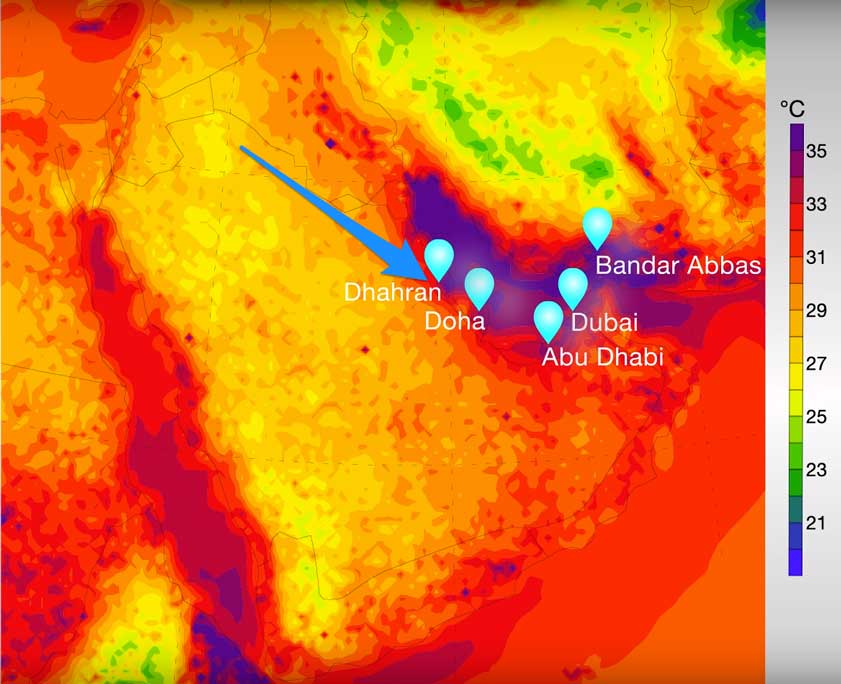NOTE: An updated and rewritten version of this posting can be found here on Medium.
Just how high does the temperature need to get before it becomes too hot for human life to be maintained?
It’s actually quite a complicated question to answer and yet there is an answer – 35C – beyond that you die.
Wait that’s crazy, it was over that temperature in many places in the UK yesterday (at time of writing several years ago), including the London underground, yet people happily thrived.
Why is 35C deadly for human life?
I did say that it would get a tad complicated.
What I’m referring to is not the normal air temperature of 35C, but rather the wet-bulb temperature of 35C. The number might be the same but a wet-bulb temperature of 35C is something quite different. It is a measurement that also considers humidity and hence the cooling effect of evaporation.
A key to understanding this is to remember that a high temperature, of say 46C, is something humans can easily survive if the air is dry, but bump up the humanity, to say 50%, and it becomes a very different story, that would yield a wet-bulb temperature of about 35C and so prolonged exposure to that will lead most strong normal health humans to die from hyperthermia. Basically you overheat.
What the heck is a Wet-Bulb Temperature?
If you wrap a thermometer with a water soaked cloth and then let the atmospheric air pass over it, you are getting a cooling effect via the evaporation of the water. The hot air might be 46C, but the evaporation from the wet cloth will cool the temperature and so the actual reading will not be 46C, but rather a lot less.
How much less?
Well, that depends upon the humidity of the air. The more humid it is the less evaporation can cool things. If for example the air at 35C was at 100% humidity, then evaporation can’t take place because the air can’t absorb any more moisture. Net effect, the wet-bulb temperature would in that case be the same as the atmospheric temperature … 35C.
In drier hot air you don’t just feel cooler, you are actually cooler. The evaporation enabled by the drier air enables you to stay a lot cooler.
Why is a 35C wet-bulb temperature fatal to humans?
Your core body temperature is 37 C and so you skin maintains a temperature of 35 C (or below) so that the core temperature can be maintained. If the wet-bulb temperature rises above 35C then no matter how much you sweat, it will not cool you below that critical 35C. Unless you gain access to air conditioning then you will overheat. The word used to describe that is Hyperthermia – the opposite of hypothermia (too cold). It is perhaps more common to call it heat stroke.
Today the wet-bulb temperature generally never exceeds 30 or 31C, but in a warming world we are fast approaching a time when we will hit and then pass that 35C limit.
Not even the fittest of humans can survive, even in well-ventilated shaded conditions, when the wet-bulb temperature stays above 35C.
Future temperature in southwest Asia projected to exceed a threshold for human adaptability
The above paper explains …
A human body may be able to adapt to extremes of dry-bulb temperature (commonly referred to as simply temperature) through perspiration and associated evaporative cooling provided that the wet-bulb temperature (a combined measure of temperature and humidity or degree of ‘mugginess’) remains below a threshold of 35 °C. (ref. 1). This threshold defines a limit of survivability for a fit human under well-ventilated outdoor conditions and is lower for most people. We project using an ensemble of high-resolution regional climate model simulations that extremes of wet-bulb temperature in the region around the Arabian Gulf are likely to approach and exceed this critical threshold under the business-as-usual scenario of future greenhouse gas concentrations. Our results expose a specific regional hotspot where climate change, in the absence of significant mitigation, is likely to severely impact human habitability in the future.
Further Reading
Read the New York Times article titled “In India, Summer Heat May Soon Be Literally Unbearable”, to get a feel for what is already happening now. It’s long and does not fly above it all at 30,000 ft, but takes you right into the lives of individuals.
Extreme heat is devastating the health and livelihoods of tens of millions more.
If global greenhouse gas emissions continue at their current pace, they say, heat and humidity levels could become unbearable, especially for the poor.
It is already making them poorer and sicker. Like the Kolkata street vendor who squats on his haunches from fatigue and nausea. Like the woman who sells water to tourists in Delhi and passes out from heatstroke at least once each summer. Like the women and men with fever and headaches who fill emergency rooms. Like the outdoor workers who become so weak or so sick that they routinely miss days of work, and their daily wages.
…
Indeed, a recent analysis of climate trends in several of South Asia’s biggest cities found that if current warming trends continued, by the end of the century, wet bulb temperatures — a measure of heat and humidity that can indicate the point when the body can no longer cool itself — would be so high that people directly exposed for six hours or more would not survive.
As time permits, I recommend reading it.
When it comes to global warming, it is not simply sea level rise that will impact us. Rising temperatures are already having an impact and as temperatures continue to rise it will render areas of the globe uninhabitable by humans.

we are doing are part by recycling ,plus oil recycle,driving less, growning food, we need to help the poor more.